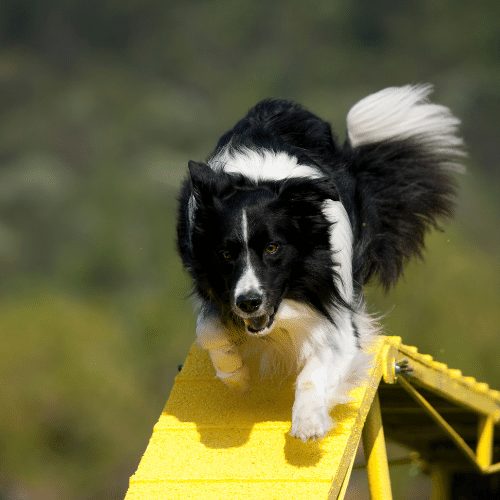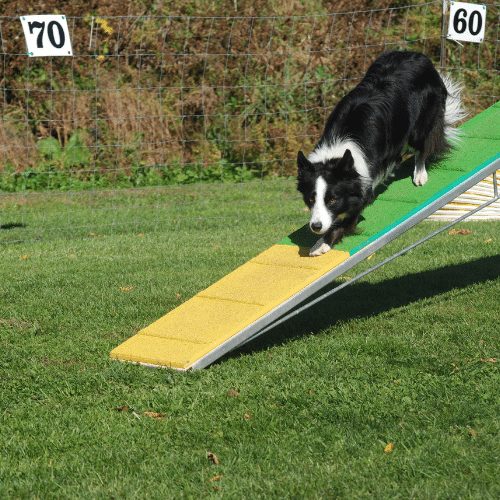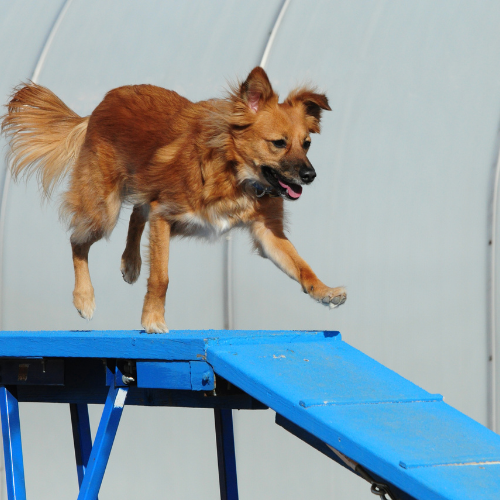Agility Dogwalk
March 26, 2021 2021-04-23 6:04The dogwalk is by far the biggest obstacle on any agility course. With its planks measuring 36 feet in total length, you cannot miss it!
Some dogs are initially apprehensive of the dogwalk. Others want to jump off the end without touching the yellow contact zone.
Let’s discover how you can train the dogwalk well!
Table of Contents

Obstacle specifications
The dogwalk consists of three planks that are 12 feet long each and 12 inches wide. The horizontal board of the dogwalk is 48″ high.
The planks themselves used to be made out of wood – newer equipment is usually made from aluminium. The surface needs to absolutely be made out of non-slip material. It could either have wooden slats as seen above, or be covered with rubber granules.
At each end of the dogwalk is the so-called contact zone. It will vary in length from 36-48″ (depending in the venue you compete in) and is always a different color from the rest of the dogwalk.
Dogs are required to touch the contact zone upon getting on and before leaving the dogwalk. This is to prevent them from injuring themselves when jumping down from up high.
The dogwalk is by far the biggest obstacle on the agility course, much bigger than even the A-frame.

Training the dogwalk
As with all contact obstacles, you should not start training before your dog has not finished growing yet. This is to avoid injuries to the growth plates. While it might be tempting to put a little puppy on the dogwalk, please don’t do that – if he falls, he could get seriously hurt and sustain a lifelong limp!
If your dog is finished growing, at a healthy weight and has good coordination, you can start to work on the dogwalk. If you are unhappy with your dog’s coordination, using a balance or wobble board can help him prepare for agility training in a safe way.
For your dog’s first time on the dogwalk, put little bits of spray cheese all along the planks. Dogs love spray cheese and usually go onto the dogwalk right away to lick it off.
You absolutely want to avoid luring your dog with a cookie in your hand. If you do that, he will look up at the treat and not see where he is going and he is likely to fall off!
Contact performance on the dogwalk
As with all contact obstacles, your dog is required to touch the contact zone at the end of the obstacle. In addition, most (though not all) agility venues require him to touch the so-called up contact (the contact at the start of the ramp).
The easiest way to teach your dog to slow down and touch the end zone is through using a target or food on the ground. If you consistently put a treat or a small plate at the end of the dogwalk, your dog will start to expect it there and naturally slow down.
A more involved training option is to teach your dog “running contacts”. During this training process, he learns to hit the contact zone at full speed. This is a very tricky skill and not all owner succeed in training it.
If you own a small dog at or under 15 pounds, chances are that he will hit the contact zone automatically. The striding of small dogs is short enough to allow them to touch the yellow zone without making any adjustments.
Dogs that are scared of the dogwalk
Some dogs are initially scared of the dogwalk. This might be either due to a fear of heights or due to the dog being uncertain how to navigate the narrow plank. You can help your dog improve his coordination and confidence by playing with him on many unstable surfaces.
Wobble boards are great for this. You can also use a plank suspended between two stepping stools to have your dog practice walking, turning, sitting and lying down on a plank. Use plenty of treats to help your dog enjoy and get confident.
Note: A leash should never be used to force your dog onto the dogwalk (or a board). This will only increase his apprehension and make it harder for him to get comfortable. We need your dog to step onto it by his own free choice!
Some dogs learn to navigate the dogwalk in one single training session. Others take a lot longer! My own little dog Party actually took 8 months to cross an entire dogwalk for the first time. I never used fear or intimidation – only positive encouragement. Today he flies across the obstacle.

DIY dogwalk
Purchasing a dogwalk is very expensive – expect to easily pay $1,200 and more for this obstacle from a specialty agility store. It is one of the obstacles that can really drive up the cost of agility training. A much more affordable option is to build your own dogwalk.
You can use three 12 feet long wooden boards. The boards could even be half that size if you have limited space. For smaller dogs, you can use 5 gallon buckets to prop them up. For larger dogs, consider using bricks.
A dogwalk does not need to be high in order to be a challenging obstacle!
Especially if your dog is just starting out, using a low DIY dogwalk is a great way to teach your dog confidence and coordination on the narrow plank without risking any injury shoud he fall down.

Dogwalk entries
Because the boards are so narrow, it is crucial that dogs enter the dogwalk in a straight approach. A decade ago, many dogwalk approaches were dangerous. They would have the dog get onto the dogwalk at an angle, risking him “flying off” when he could not control his trajectory.
Thankfully, this has changed a lot. In most agility venues, dogwalk approaches are regulated by the rule book. Straight and safe approaches are required by the judge.
It is important that you follow these guidelines when practicing agility at home as well. Never set up a course that will set up your dog in a way that he could fly off the dogwalk! Choose straight and safe approaches whenever you are training.
When you are putting up a dogwalk, it is crucial that you not only have enough space for the dogwalk itself, but also for straight entries and exists.
The Bottom Line
As the largest and arguably most dangerous obstacle on an agility course, the dogwalk needs to be trained slowly and thoughtfully. Never make the mistake to lure your dog across the dogwalk – instead put a line of spray cheese or treats onto the planks to direct his gaze downwards and have him focus on where he is going.


